The Research Agenda on Smart Grids: Foresights for Social Acceptance
Abstract
:1. Introduction
2. Materials and Methods
2.1. Research Design
2.2. Software
2.3. Data Acquisition and Refinement
3. Results
3.1. Bibliometric Analysis
3.1.1. Main Information of Data
3.1.2. Publication Types
3.1.3. Annual Publications
3.1.4. Subject Areas
3.1.5. Prolific Countries
3.1.6. Prolific Publishers and Authors
3.2. Thematic Analysis
3.2.1. Theme Density Analysis
3.2.2. Thematic Map Analysis
3.2.3. Word Cloud Analysis
3.2.4. Thematic Evolution Analysis
4. Discussion
5. Conclusions
Author Contributions
Funding
Data Availability Statement
Conflicts of Interest
References
- Alotaibi, I.; Abido, M.A.; Khalid, M.; Savkin, A.V. A Comprehensive Review of Recent Advances in Smart Grids: A Sustainable Future with Renewable Energy Resources. Energies 2020, 13, 6269. [Google Scholar] [CrossRef]
- Kumari, A.; Tanwar, S. Secure Data Analytics for Smart Grid Systems in a Sustainable Smart City: Challenges, Solutions, and Future Directions. Sustain. Comput. Inform. Syst. 2020, 28, 100427. [Google Scholar] [CrossRef]
- Majeed Butt, O.; Zulqarnain, M.; Majeed Butt, T. Recent Advancement in Smart Grid Technology: Future Prospects in the Electrical Power Network. Ain Shams Eng. J. 2021, 12, 687–695. [Google Scholar] [CrossRef]
- Dileep, G. A Survey on Smart Grid Technologies and Applications. Renew. Energy 2020, 146, 2589–2625. [Google Scholar] [CrossRef]
- Fan, X.; Liu, B.; Liu, J.; Ding, J.; Han, X.; Deng, Y.; Lv, X.; Xie, Y.; Chen, B.; Hu, W.; et al. Battery Technologies for Grid-Level Large-Scale Electrical Energy Storage. Trans. Tianjin Univ. 2020, 26, 92–103. [Google Scholar] [CrossRef]
- Rajarajeswari, R.; Suchitra, D.; Fernandez, S.G.; Rao, G.L.M. A Novel Demand Side Management Scheme for Residential Buildings Using Smart System. Int. J. Renew. Energy Res. 2021, 11, 1652–1662. [Google Scholar]
- AlKassem, A.I. The Integration of Intermittent Renewable Energy Sources to Smart Grid: A Comprehensive View. Int. J. Renew. Energy Res. 2022, 12, 1614–1627. [Google Scholar]
- Zafar, U.; Bayhan, S.; Sanfilippo, A. Home Energy Management System Concepts, Configurations, and Technologies for the Smart Grid. IEEE Access 2020, 8, 119271–119286. [Google Scholar] [CrossRef]
- Gao, Y.; Fang, C.; Zhang, J. A Spatial Analysis of Smart Meter Adoptions: Empirical Evidence from the U.S. Data. Sustainability 2022, 14, 1126. [Google Scholar] [CrossRef]
- Osman, A.I.; Chen, L.; Yang, M.; Msigwa, G.; Farghali, M.; Fawzy, S.; Rooney, D.W.; Yap, P.-S. Cost, Environmental Impact, and Resilience of Renewable Energy under a Changing Climate: A Review. Environ. Chem. Lett. 2023, 21, 741–764. [Google Scholar] [CrossRef]
- Saleem, M.U.; Shakir, M.; Usman, M.R.; Bajwa, M.H.T.; Shabbir, N.; Shams Ghafaroki, P.; Daniel, K. Integrating Smart Energy Management System with Internet of Things and Cloud Computing for Efficient Demand Side Management in Smart Grids. Energies 2023, 16, 4835. [Google Scholar] [CrossRef]
- Chantzis, G.; Giama, E.; Papadopoulos, A.M. Building Energy Flexibility Assessment in Mediterranean Climatic Conditions: The Case of a Greek Office Building. Appl. Sci. 2023, 13, 7246. [Google Scholar] [CrossRef]
- Kumar, G.M.S.; Cao, S. State-of-the-Art Review of Positive Energy Building and Community Systems. Energies 2021, 14, 5046. [Google Scholar] [CrossRef]
- Owunna, T.A.; Obeagu, E.I. Overview of Smart Grid Technology as a Renewable Energy Source. J. Energy Res. Rev. 2022, 12, 6–15. [Google Scholar] [CrossRef]
- Vlasov, A.; Adamova, A.; Selivanov, K. Development of Smart Grid Technologies: Organizational and Communication Aspects. E3S Web Conf. 2021, 250, 8001. [Google Scholar] [CrossRef]
- Ghofrani, M.; Detert, E.; Hosseini, N.N.; Arabali, A.; Myers, N.; Ngin, P.; Ghofrani, M.; Detert, E.; Hosseini, N.N.; Arabali, A.; et al. V2G Services for Renewable Integration. In Modeling and Simulation for Electric Vehicle Applications; IntechOpen: London, UK, 2016; ISBN 978-953-51-2637-9. [Google Scholar]
- Nasir, T.; Bukhari, S.S.H.; Raza, S.; Munir, H.M.; Abrar, M.; Muqeet, H.A.; Bhatti, K.L.; Ro, J.-S.; Masroor, R. Recent Challenges and Methodologies in Smart Grid Demand Side Management: State-of-the-Art Literature Review. Math. Probl. Eng. 2021, 2021, e5821301. [Google Scholar] [CrossRef]
- Şenyapar, H.N.D. A Bibliometric Analysis on Renewable Energy’s Public Health Benefits. J. Energy Syst. 2023, 7, 132–157. [Google Scholar] [CrossRef]
- Tirunagari, S.; Gu, M.; Meegahapola, L. Reaping the Benefits of Smart Electric Vehicle Charging and Vehicle-to-Grid Technologies: Regulatory, Policy and Technical Aspects. IEEE Access 2022, 10, 114657–114672. [Google Scholar] [CrossRef]
- Memari, M.; Karimi, A.; Hashemi-Dezaki, H. Reliability Evaluation of Smart Grid Using Various Classic and Metaheuristic Clustering Algorithms Considering System Uncertainties. Int. Trans. Electr. Energy Syst. 2021, 31, e12902. [Google Scholar] [CrossRef]
- Demir, K.; Hauke, S. Towards a Testbed for Dependable Power Distribution Grids. Bitlis Eren Üniv. Fen Bilim. Derg. 2020, 9, 1865–1871. [Google Scholar] [CrossRef]
- Chen, Z.; Amani, A.M.; Yu, X.; Jalili, M. Control and Optimisation of Power Grids Using Smart Meter Data: A Review. Sensors 2023, 23, 2118. [Google Scholar] [CrossRef] [PubMed]
- Ismeil, M.A.; Hussein, H.S.; Farrag, M.; Nasrallah, M. Transmission and Distribution Smart Grid System Based on Self-Hailing Controllable Crowbar. IEEE Access 2023, 11, 10149–10157. [Google Scholar] [CrossRef]
- Stanchev, P.; Vacheva, G.; Hinov, N. Evaluation of Voltage Stability in Microgrid-Tied Photovoltaic Systems. Energies 2023, 16, 4895. [Google Scholar] [CrossRef]
- Sagiroglu, S. Big Data and Cyber Security Issues in Smart Grids. In Proceedings of the 9th International Conference on Smart Grid (icSmartGrid), Setubal, Portugal, 29 June–1 July 2021; p. 16. [Google Scholar]
- Guerrero-Sánchez, A.E.; Rivas-Araiza, E.A.; Garduño-Aparicio, M.; Tovar-Arriaga, S.; Rodriguez-Resendiz, J.; Toledano-Ayala, M. A Novel Methodology for Classifying Electrical Disturbances Using Deep Neural Networks. Technologies 2023, 11, 82. [Google Scholar] [CrossRef]
- Sarathkumar, D.; Srinivasan, M.; Stonier, A.A.; Samikannu, R.; Dasari, N.R.; Raj, R.A. A Technical Review on Self-Healing Control Strategy for Smart Grid Power Systems. IOP Conf. Ser. Mater. Sci. Eng. 2021, 1055, 12153. [Google Scholar] [CrossRef]
- Srivastava, I.; Bhat, S.; Singh, A.R. Smart Grid Communication: Recent Trends and Challenges. In Next Generation Smart Grids: Modeling, Control and Optimization; Salkuti, S.R., Ray, P., Eds.; Lecture Notes in Electrical Engineering; Springer Nature: Singapore, 2022; pp. 49–75. ISBN 9789811677946. [Google Scholar]
- Smagulova, S.; Yermukhanbetova, A.; Nurgaliyeva, K.; Sariya, B.; Baimukasheva, Z.; Manap, A.; Koyshinova, G.; Akimbekova, C. The Impact of Energy Production on the Introduction of ICT and the Growth of AIC in Kazakhstan. Int. J. Energy Econ. Policy 2023, 13, 477–488. [Google Scholar] [CrossRef]
- Elshaafi, H.; Vinyals, M.; Grimaldi, I.; Davy, S. Secure Automated Home Energy Management in Multi-Agent Smart Grid Architecture. Technol. Econ. Smart Grids Sustain. Energy 2018, 3, 4. [Google Scholar] [CrossRef]
- Arfa, S.; Ben Ammar, M.; Zdiri, M.A.; Abdallah, H.H. Multi-Source Renewable Energy Exchange Management System for off-Grid Home Load. Int. J. Renew. Energy Res. 2022, 12, 1463–1474. [Google Scholar]
- Kumar, P.V.; Ravindra, K.V.; Kumar, T.N.V.L.N. Smart Grid on Issues and Challenges. Int. J. Recent Technol. Eng. 2019, 8, 4628–4632. [Google Scholar] [CrossRef]
- Lobaccaro, G.; Carlucci, S.; Löfström, E. A Review of Systems and Technologies for Smart Homes and Smart Grids. Energies 2016, 9, 348. [Google Scholar] [CrossRef]
- Gomes, L.; Coelho, A.; Vale, Z. Assessment of Energy Customer Perception, Willingness, and Acceptance to Participate in Smart Grids—A Portuguese Survey. Energies 2023, 16, 270. [Google Scholar] [CrossRef]
- Durmus Senyapar, H.N.; Akil, M.; Dokur, E. Adoption of Electric Vehicles: Purchase Intentions and Consumer Behaviors Research in Turkey. Sage Open 2023, 13, 2. [Google Scholar] [CrossRef]
- Karakitsios, I.; Lagos, D.; Dimeas, A.; Hatziargyriou, N. How Can EVs Support High RES Penetration in Islands. Energies 2023, 16, 558. [Google Scholar] [CrossRef]
- Mirshafiee, F.; Shahbazi, E.; Safi, M.; Rituraj, R. Predicting Power and Hydrogen Generation of a Renewable Energy Converter Utilizing Data-Driven Methods: A Sustainable Smart Grid Case Study. Energies 2023, 16, 502. [Google Scholar] [CrossRef]
- Marinescu, C. Progress in the Development and Implementation of Residential EV Charging Stations Based on Renewable Energy Sources. Energies 2023, 16, 179. [Google Scholar] [CrossRef]
- Townsend, J.H.; Coroama, V.C. Digital Acceleration of Sustainability Transition: The Paradox of Push Impacts. Sustainability 2018, 10, 2816. [Google Scholar] [CrossRef]
- Rigogiannis, N.; Bogatsis, I.; Pechlivanis, C.; Kyritsis, A.; Papanikolaou, N. Moving towards Greener Road Transportation: A Review. Clean Technol. 2023, 5, 766–790. [Google Scholar] [CrossRef]
- Al-Rawashdeh, H.; Al-Khashman, O.A.; Al Bdour, J.T.; Gomaa, M.R.; Rezk, H.; Marashli, A.; Arrfou, L.M.; Louzazni, M. Performance Analysis of a Hybrid Renewable-Energy System for Green Buildings to Improve Efficiency and Reduce GHG Emissions with Multiple Scenarios. Sustainability 2023, 15, 7529. [Google Scholar] [CrossRef]
- Trane, M.; Marelli, L.; Siragusa, A.; Pollo, R.; Lombardi, P. Progress by Research to Achieve the Sustainable Development Goals in the EU: A Systematic Literature Review. Sustainability 2023, 15, 7055. [Google Scholar] [CrossRef]
- Liu, J.; Hu, H.; Yu, S.S.; Trinh, H. Electricity Pricing and Its Role in Modern Smart Energy System Design: A Review. Designs 2023, 7, 76. [Google Scholar] [CrossRef]
- Çolak, M.; Irmak, E. A State-of-the-Art Review on Electric Power Systems and Digital Transformation. Electr. Power Compon. Syst. 2023, 51, 1089–1112. [Google Scholar] [CrossRef]
- IEA. Smart Grids—Analysis. Available online: https://www.iea.org/reports/smart-grids (accessed on 2 June 2023).
- OECD. Support for Fossil Fuels Almost Doubled in 2021, Slowing Progress toward International Climate Goals, According to New Analysis from OECD and IEA. Available online: https://www.oecd.org/newsroom/support-for-fossil-fuels-almost-doubled-in-2021-slowing-progress-toward-international-climate-goals-according-to-new-analysis-from-oecd-and-iea.htm (accessed on 2 June 2023).
- Baur, D.; Emmerich, P.; Baumann, M.J.; Weil, M. Assessing the Social Acceptance of Key Technologies for the German Energy Transition. Energy Sustain. Soc. 2022, 12, 4. [Google Scholar] [CrossRef]
- Moreno Escobar, J.J.; Morales Matamoros, O.; Tejeida Padilla, R.; Lina Reyes, I.; Quintana Espinosa, H. A Comprehensive Review on Smart Grids: Challenges and Opportunities. Sensors 2021, 21, 6978. [Google Scholar] [CrossRef] [PubMed]
- Dorji, S.; Stonier, A.A.; Peter, G.; Kuppusamy, R.; Teekaraman, Y. An Extensive Critique on Smart Grid Technologies: Recent Advancements, Key Challenges, and Future Directions. Technologies 2023, 11, 81. [Google Scholar] [CrossRef]
- Archana. Exploring the Acceptance of Smart Grid Technology in India: Role of Government Policies and Regulatory Framework. Int. J. Electron. Gov. Res. 2022, 18, 1–30. [Google Scholar] [CrossRef]
- Ellabban, O.; Abu-Rub, H. Smart Grid Customers’ Acceptance and Engagement: An Overview. Renew. Sustain. Energy Rev. 2016, 65, 1285–1298. [Google Scholar] [CrossRef]
- Milchram, C.; Van de Kaa, G.; Doorn, N.; Künneke, R. Moral Values as Factors for Social Acceptance of Smart Grid Technologies. Sustainability 2018, 10, 2703. [Google Scholar] [CrossRef]
- Bigerna, S.; Bollino, C.A.; Micheli, S. Smart Grids and Consumer Attitude Toward Sustainable Development. J. Promot. Manag. 2016, 22, 573–587. [Google Scholar] [CrossRef]
- Archana Modelling Barriers for Smart Grid Technology Acceptance in India. Process Integr. Optim. Sustain. 2022, 6, 989–1010. [CrossRef]
- Bhattacharya, S.; Chengoden, R.; Srivastava, G.; Alazab, M.; Javed, A.R.; Victor, N.; Reddy, P.; Gadekallu, T. Incentive Mechanisms for Smart Grid: State of the Art, Challenges, Open Issues, Future Directions. Big Data Cogn. Comput. 2022, 6, 47. [Google Scholar] [CrossRef]
- Wolsink, M. The Research Agenda on Social Acceptance of Distributed Generation in Smart Grids: Renewable as Common Pool Resources. Renew. Sustain. Energy Rev. 2012, 16, 822–835. [Google Scholar] [CrossRef]
- Bigerna, S.; Bollino, C.A.; Micheli, S. Socio-Economic Acceptability for Smart Grid Development—A Comprehensive Review. J. Clean. Prod. 2016, 131, 399–409. [Google Scholar] [CrossRef]
- Kojonsaari, A.-R.; Palm, J. The Development of Social Science Research on Smart Grids: A Semi-Structured Literature Review. Energy Sustain. Soc. 2023, 13, 1. [Google Scholar] [CrossRef]
- Ayik, S.; Durmus Senyapar, H.N.; Bayindir, R. Social Adoption of Smart Grids: The Research Agenda. In Proceedings of the 11th International Conference on Smart Grid (icSmartGrid), Paris, France, 4 June 2023; pp. 1–5. [Google Scholar]
- Alshater, M.M.; Saad, R.A.J.; Abd Wahab, N.; Saba, I. What Do We Know about Zakat Literature? A Bibliometric Review. J. Islam. Account. Bus. Res. 2021, 12, 544–563. [Google Scholar] [CrossRef]
- Puppis, M. Analyzing Talk and Text I: Qualitative Content Analysis. In The Palgrave Handbook of Methods for Media Policy Research; Van den Bulck, H., Puppis, M., Donders, K., Van Audenhove, L., Eds.; Springer International Publishing: Cham, Switzerland, 2019; pp. 367–384. ISBN 978-3-030-16065-4. [Google Scholar]
- Al-Emran, M.; Griffy-Brown, C. The Role of Technology Adoption in Sustainable Development: Overview, Opportunities, Challenges, and Future Research Agendas. Technol. Soc. 2023, 73, 102240. [Google Scholar] [CrossRef]
- Ferreira, P.; Rocha, A.; Araujo, M.; Afonso, J.L.; Antunes, C.H.; Lopes, M.A.R.; Osório, G.J.; Catalão, J.P.S.; Lopes, J.P. Assessing the Societal Impact of Smart Grids: Outcomes of a Collaborative Research Project. Technol. Soc. 2023, 72, 102164. [Google Scholar] [CrossRef]
- Bayindir, R.; Colak, I.; Fulli, G.; Demirtas, K. Smart Grid Technologies and Applications. Renew. Sustain. Energy Rev. 2016, 66, 499–516. [Google Scholar] [CrossRef]
- Heath, C.; Knoblauch, H.; Luff, P. Technology and Social Interaction: The Emergence of “Workplace Studies”. Br. J. Sociol. 2000, 51, 299–320. [Google Scholar] [CrossRef]
- Vakulenko, I.; Saher, L.; Oleksii, L.; Pimonenko, T. A Systematic Literature Review of Smart Grids. E3S Web Conf. 2021, 250, 8006. [Google Scholar] [CrossRef]
- Ghiasi, M.; Niknam, T.; Wang, Z.; Mehrandezh, M.; Dehghani, M.; Ghadimi, N. A Comprehensive Review of Cyber-Attacks and Defense Mechanisms for Improving Security in Smart Grid Energy Systems: Past, Present and Future. Electr. Power Syst. Res. 2023, 215, 108975. [Google Scholar] [CrossRef]
- Statista. Renewable Energy Capacity Worldwide by Country. 2022. Available online: https://www.statista.com/statistics/267233/renewable-energy-capacity-worldwide-by-country/ (accessed on 1 June 2023).
- Irena. Annual Renewable Power Must Triple by 2030. Available online: https://www.irena.org/News/pressreleases/2023/Jun/Annual-Renewable-Power-Must-Triple-by-2030 (accessed on 2 June 2023).
- Sood, V.K.; Fischer, D.; Eklund, J.M.; Brown, T. Developing a Communication Infrastructure for the Smart Grid. In Proceedings of the 2009 IEEE Electrical Power & Energy Conference (EPEC), Montreal, QC, Canada, 22–23 October 2009; pp. 1–7. [Google Scholar]
- Ma, Z.; Norregaard, B.; Asmussen, A. Industrial Consumers’ Acceptance to the Smart Grid Solutions: Case Studies from Denmark. In Proceedings of the 2015 IEEE Innovative Smart Grid Technologies-Asia (ISGT ASIA), Bangkok, Thailand, 3–6 November 2015; pp. 1–6. [Google Scholar]
- Zheng, Y.; Stanton, J.; Ramnarine-Rieks, A.; Dedrick, J. Proceeding with Caution: Drivers and Obstacles to Electric Utility Adoption of Smart Grids in the United States. Energy Res. Soc. Sci. 2022, 93, 102839. [Google Scholar] [CrossRef]
- Good, N.; Ellis, K.A.; Mancarella, P. Review and Classification of Barriers and Enablers of Demand Response in the Smart Grid. Renew. Sustain. Energy Rev. 2017, 72, 57–72. [Google Scholar] [CrossRef]
- De Wildt, T.E.; Chappin, E.J.L.; van de Kaa, G.; Herder, P.M.; van de Poel, I.R. Conflicting Values in the Smart Electricity Grid a Comprehensive Overview. Renew. Sustain. Energy Rev. 2019, 111, 184–196. [Google Scholar] [CrossRef]
- Ahadipour, A.; Mohammadi, M.; Keshavarz-Haddad, A. Statistical-Based Privacy-Preserving Scheme with Malicious Consumers Identification for Smart Grid. arXiv 2019, arXiv:1904.06576. [Google Scholar]
- Olabi, A.G.; Abdelkareem, M.A.; Jouhara, H. Energy Digitalization: Main Categories, Applications, Merits, and Barriers. Energy 2023, 271, 126899. [Google Scholar] [CrossRef]
- Boakye-Boateng, K.; Ghorbani, A.A.; Lashkari, A.H. A Trust-Influenced Smart Grid: A Survey and a Proposal. J. Sens. Actuator Netw. 2022, 11, 34. [Google Scholar] [CrossRef]
- Gumz, J.; Fettermann, D.; Sant’Anna, Â.; Tortorella, G. Social Influence as a Major Factor in Smart Meters’ Acceptance: Findings from Brazil. Results Eng. 2022, 15, 100510. [Google Scholar] [CrossRef]
- Hargreaves, N.; Hargreaves, T.; Chilvers, J. Socially Smart Grids? A Multi-Criteria Mapping of Diverse Stakeholder Perspectives on Smart Energy Futures in the United Kingdom. Energy Res. Soc. Sci. 2022, 90, 102610. [Google Scholar] [CrossRef]
- Norouzi, F.; Hoppe, T.; Elizondo, L.R.; Bauer, P. A Review of Socio-Technical Barriers to Smart Microgrid Development. Renew. Sustain. Energy Rev. 2022, 167, 112674. [Google Scholar] [CrossRef]
- Gupta, N.; Fischer, A.R.H.; Frewer, L.J. Socio-Psychological Determinants of Public Acceptance of Technologies: A Review. Public Underst. Sci. 2012, 21, 782–795. [Google Scholar] [CrossRef]
- Li, C.; Li, Y. Factors Influencing Public Risk Perception of Emerging Technologies: A Meta-Analysis. Sustainability 2023, 15, 3939. [Google Scholar] [CrossRef]
- Katina, P.; Keating, C.; Zio, E.; Gheorghe, A. A Criticality-Based Approach for the Analysis of Smart Grids. Technol. Econ. Smart Grids Sustain. Energy 2016, 1, 14. [Google Scholar] [CrossRef]
- Park, E. Social Acceptance of Renewable Energy Technologies in the Post-Fukushima Era. Front. Psychol. 2021, 11, 612090. [Google Scholar] [CrossRef] [PubMed]
- Huijts, N.M.A.; Molin, E.J.E.; Steg, L. Psychological Factors Influencing Sustainable Energy Technology Acceptance: A Review-Based Comprehensive Framework. Renew. Sustain. Energy Rev. 2012, 16, 525–531. [Google Scholar] [CrossRef]
- Perri, C.; Giglio, C.; Corvello, V. Smart Users for Smart Technologies: Investigating the Intention to Adopt Smart Energy Consumption Behaviors. Technol. Forecast. Soc. Change 2020, 155, 119991. [Google Scholar] [CrossRef]
- Jung, S.; Kim, D.; Shin, N. Success Factors of the Adoption of Smart Factory Transformation: An Examination of Korean Manufacturing SMEs. IEEE Access 2023, 11, 2239–2249. [Google Scholar] [CrossRef]
- Gimpel, H.; Graf, V.; Graf-Drasch, V. A Comprehensive Model for Individuals’ Acceptance of Smart Energy Technology—A Meta-Analysis. Energy Policy 2019, 138, 111196. [Google Scholar] [CrossRef]
- Peters, D.; Axsen, J.; Mallett, A. The Role of Environmental Framing in Socio-Political Acceptance of Smart Grid: The Case of British Columbia, Canada. Renew. Sustain. Energy Rev. 2017, 82, 1939–1951. [Google Scholar] [CrossRef]
- Strielkowski, W. Social and Economic Implications for the Smart Grids of the Future. Econ. Sociol. 2017, 10, 310–318. [Google Scholar] [CrossRef]
- Tamilmani, K.; Rana, N.; Dwivedi, Y.K.; Sahu, G.; Roderick, S. Exploring the Role of “Price Value” for Understanding Consumer Adoption of Technology: A Review and Meta-Analysis of UTAUT2 Based Empirical Studies. In Proceedings of the Pacific Asia Conference on Information Systems (PACIS 2018), Yokohama, Japan, 26 June 2018. [Google Scholar]
- Krishnamurti, T.; Schwartz, D.; Davis, A.; Fischhoff, B.; de Bruin, W.B.; Lave, L.; Wang, J. Preparing for Smart Grid Technologies: A Behavioral Decision Research Approach to Understanding Consumer Expectations about Smart Meters. Energy Policy 2012, 41, 790–797. [Google Scholar] [CrossRef]
- Li, R.; Dane, G.; Finck, C.; Zeiler, W. Are Building Users Prepared for Energy Flexible Buildings?—A Large-Scale Survey in the Netherlands. Appl. Energy 2017, 203, 623–634. [Google Scholar] [CrossRef]
- Ponce, P.; Polasko, K.; Molina, A. End User Perceptions toward Smart Grid Technology: Acceptance, Adoption, Risks, and Trust. Renew. Sustain. Energy Rev. 2016, 60, 587–598. [Google Scholar] [CrossRef]
- Broman Toft, M.; Schuitema, G.; Thøgersen, J. Responsible Technology Acceptance: Model Development and Application to Consumer Acceptance of Smart Grid Technology. Appl. Energy 2014, 134, 392–400. [Google Scholar] [CrossRef]
- Park, C.-K.; Kim, H.-J.; Kim, Y.-S. A Study of Factors Enhancing Smart Grid Consumer Engagement. Energy Policy 2014, 72, 211–218. [Google Scholar] [CrossRef]
- Park, C.; Kim, H.; Yong, T. Dynamic Characteristics of Smart Grid Technology Acceptance. Energy Proc. 2017, 128, 187–193. [Google Scholar] [CrossRef]
- Bugden, D.; Stedman, R. A Synthetic View of Acceptance and Engagement with Smart Meters in the United States. Energy Res. Soc. Sci. 2019, 47, 137–145. [Google Scholar] [CrossRef]
- Alkawsi, G.; Ali, N.; Mohamed, Y. An Empirical Study of the Acceptance of IoT-Based Smart Meter in Malaysia: The Effect of Electricity-Saving Knowledge and Environmental Awareness. IEEE Access 2020, 8, 42794–42804. [Google Scholar] [CrossRef]
- Beaulieu, A.; De Wilde, J.; Scherpen, J.M.A. Bridging Old and New Energy Systems. In Smart Grids from a Global Perspective; Springer International Publishing: Cham, Switzerland, 2016; ISBN 978-3-319-28075-2. [Google Scholar]
- Boer, P.; Verhaegh, N. Smart Grid Pilot Projects and Implementation in the Field. In Smart Grids from a Global Perspective; Power Systems Book Series; Springer: Berlin/Heidelberg, Germany, 2016; pp. 235–248. ISBN 978-3-319-28075-2. [Google Scholar]
- Rausser, G.; Strielkowski, W.; Streimikiene, D. Smart Meters and Household Electricity Consumption: A Case Study in Ireland. Energy Environ. 2017, 29, 131–146. [Google Scholar] [CrossRef]
- Raimi, K.; Carrico, A. Understanding and Beliefs about Smart Energy Technology. Energy Res. Soc. Sci. 2016, 12, 68–74. [Google Scholar] [CrossRef]
- Bugden, D.; Stedman, R. Unfulfilled Promise: Social Acceptance of the Smart Grid. Environ. Res. Lett. 2021, 16, 34019. [Google Scholar] [CrossRef]
- Verbong, G.P.J.; Beemsterboer, S.; Sengers, F. Smart Grids or Smart Users? Involving Users in Developing a Low Carbon Electricity Economy. Energy Policy 2013, 52, 117–125. [Google Scholar] [CrossRef]
- Geelen, D.; Reinders, A.; Keyson, D. Empowering the End-User in Smart Grids: Recommendations for the Design of Products and Services. Energy Policy 2013, 61, 151–161. [Google Scholar] [CrossRef]
- Moreno-Munoz, A.; Bellido, F.; Siano, P.; Gómez-Nieto, M. Mobile Social Media for Smart Grids Customer Engagement: Emerging Trends and Challenges. Renew. Sustain. Energy Rev. 2016, 53, 1611–1616. [Google Scholar] [CrossRef]
- Metz, A.; Kainz, K.; Boaz, A. Intervening for Sustainable Change: Tailoring Strategies to Align with Values and Principles of Communities. Front. Health Serv. 2023, 2, 959386. [Google Scholar] [CrossRef]
- Mrabet, Z.E.; Ghazi, H.E.; Kaabouch, N.; Ghazi, H.E. Cyber-Security in Smart Grid: Survey and Challenges. Comput. Electr. Eng. 2018, 67, 469–482. [Google Scholar] [CrossRef]
- Leverett, E.; Clayton, R.; Anderson, R.; Baldini, G. Standardisation and Certification of Safety, Security and Privacy in the ‘Internet of Things’; Publications Office of the European Union: Luxembourg, 2017; ISBN 978-92-79-77862-9. [Google Scholar]
- Chattopadhyay, A.; Lam, K.-Y.; Tavva, Y. Autonomous Vehicle: Security by Design. IEEE Trans. Intell. Transp. Syst. 2021, 22, 7015–7029. [Google Scholar] [CrossRef]
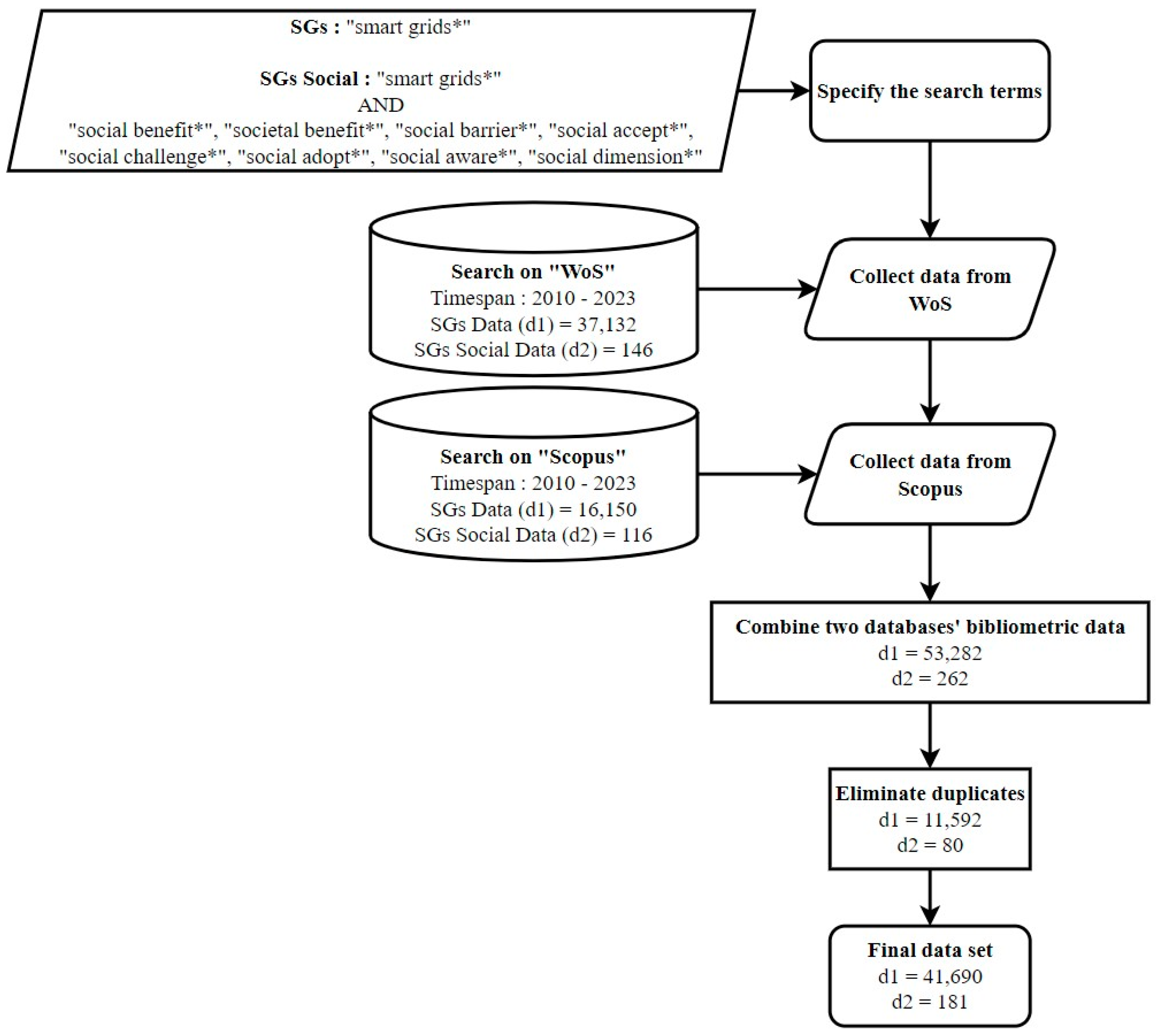
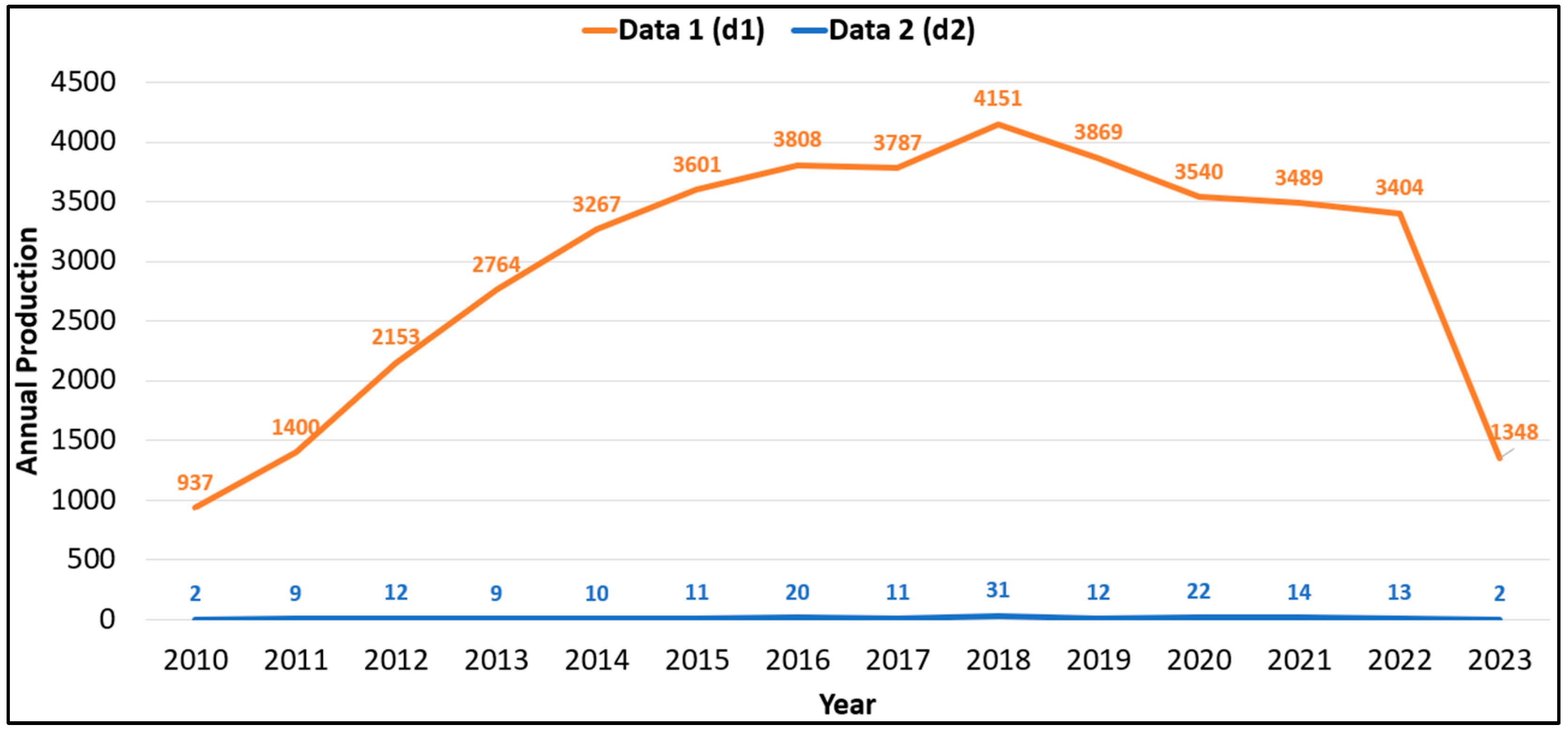

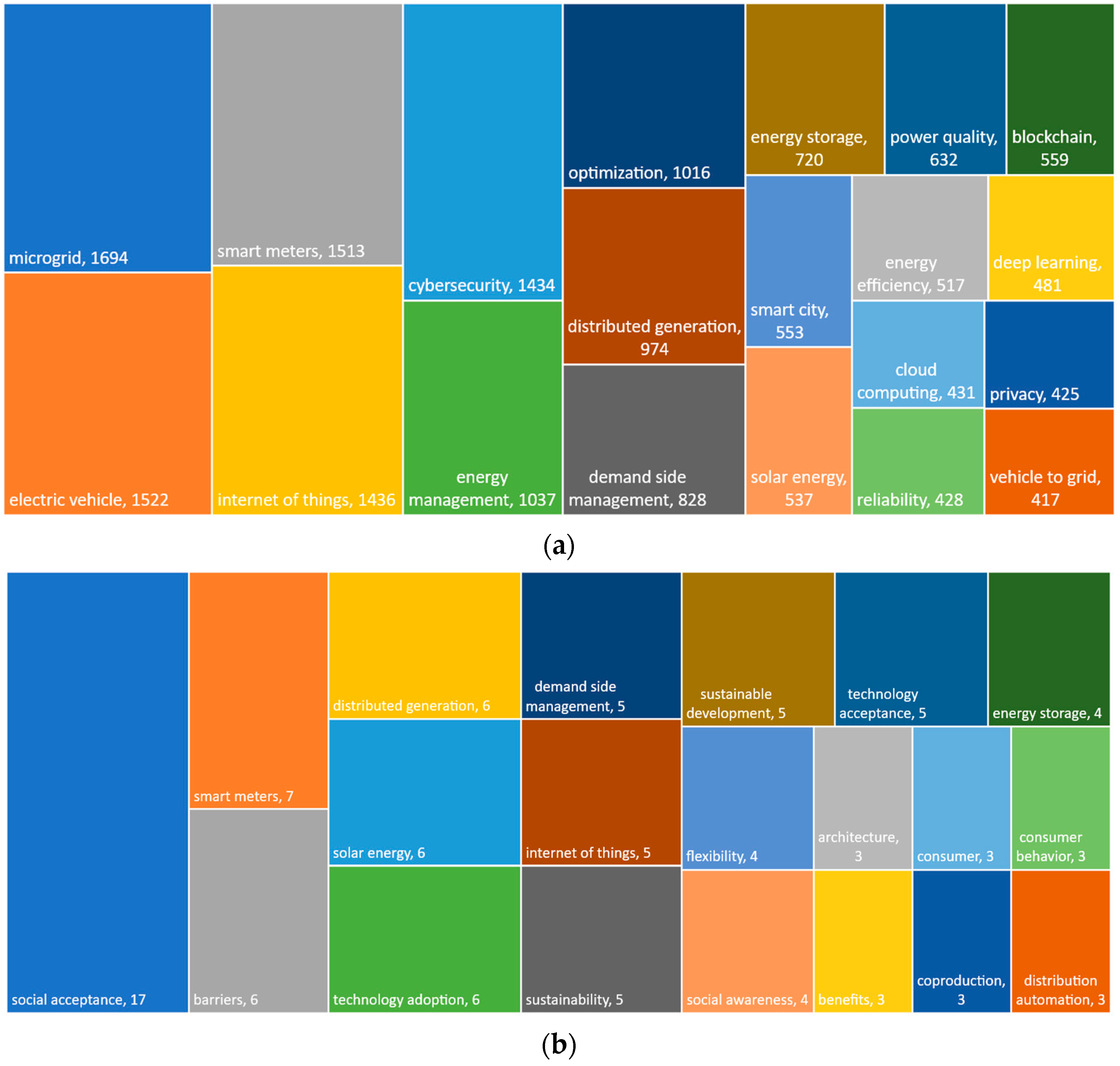
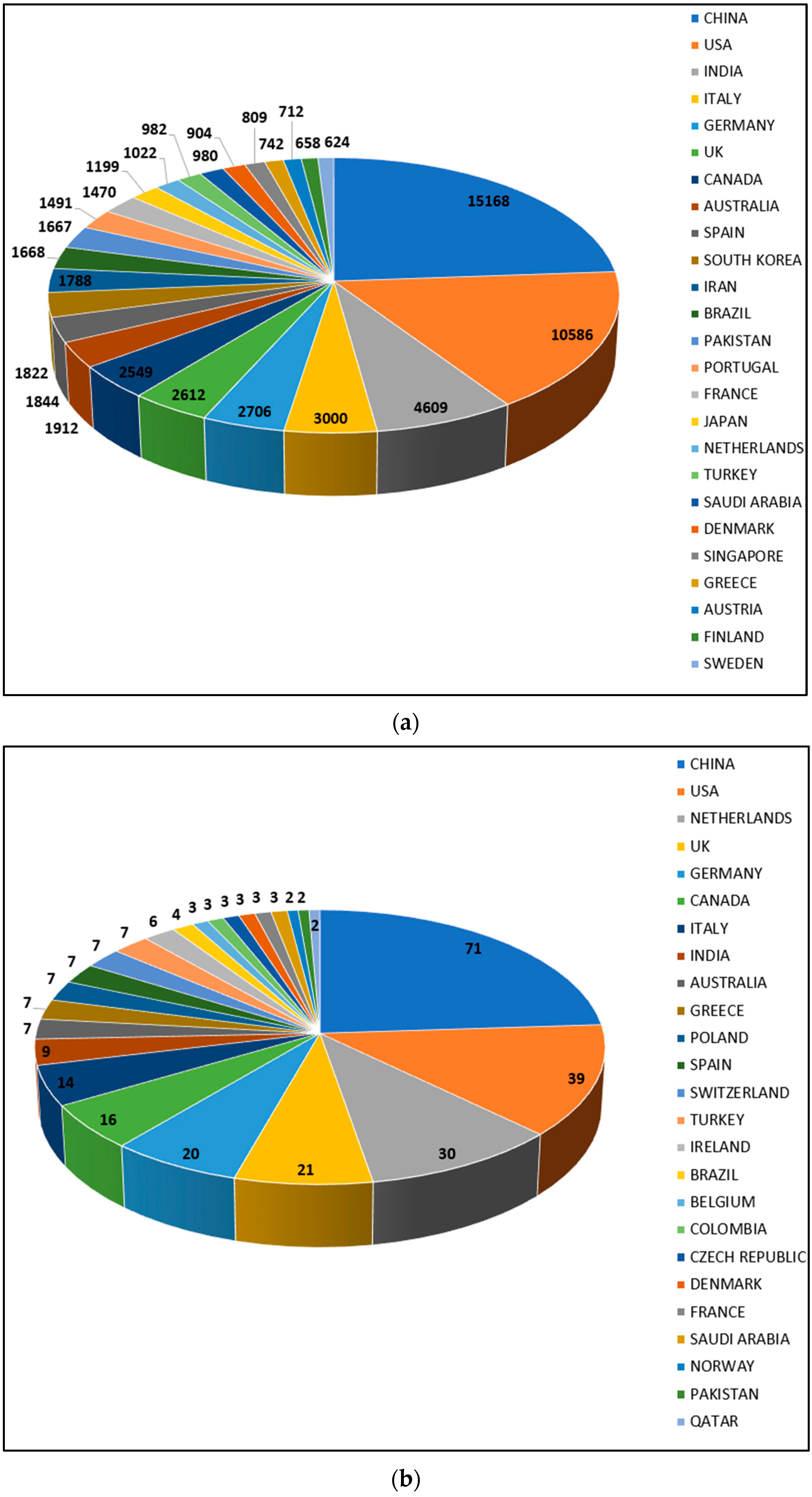
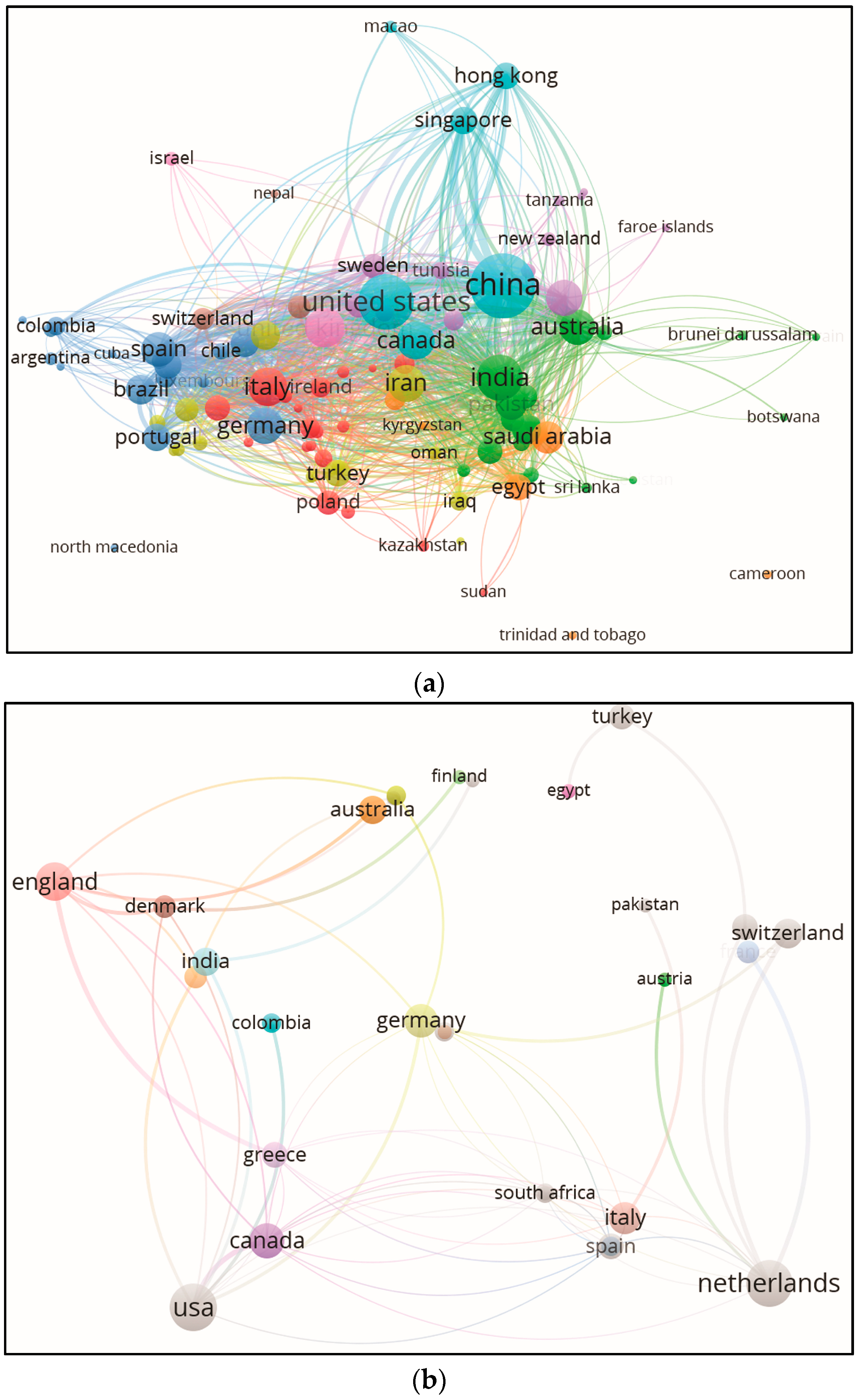
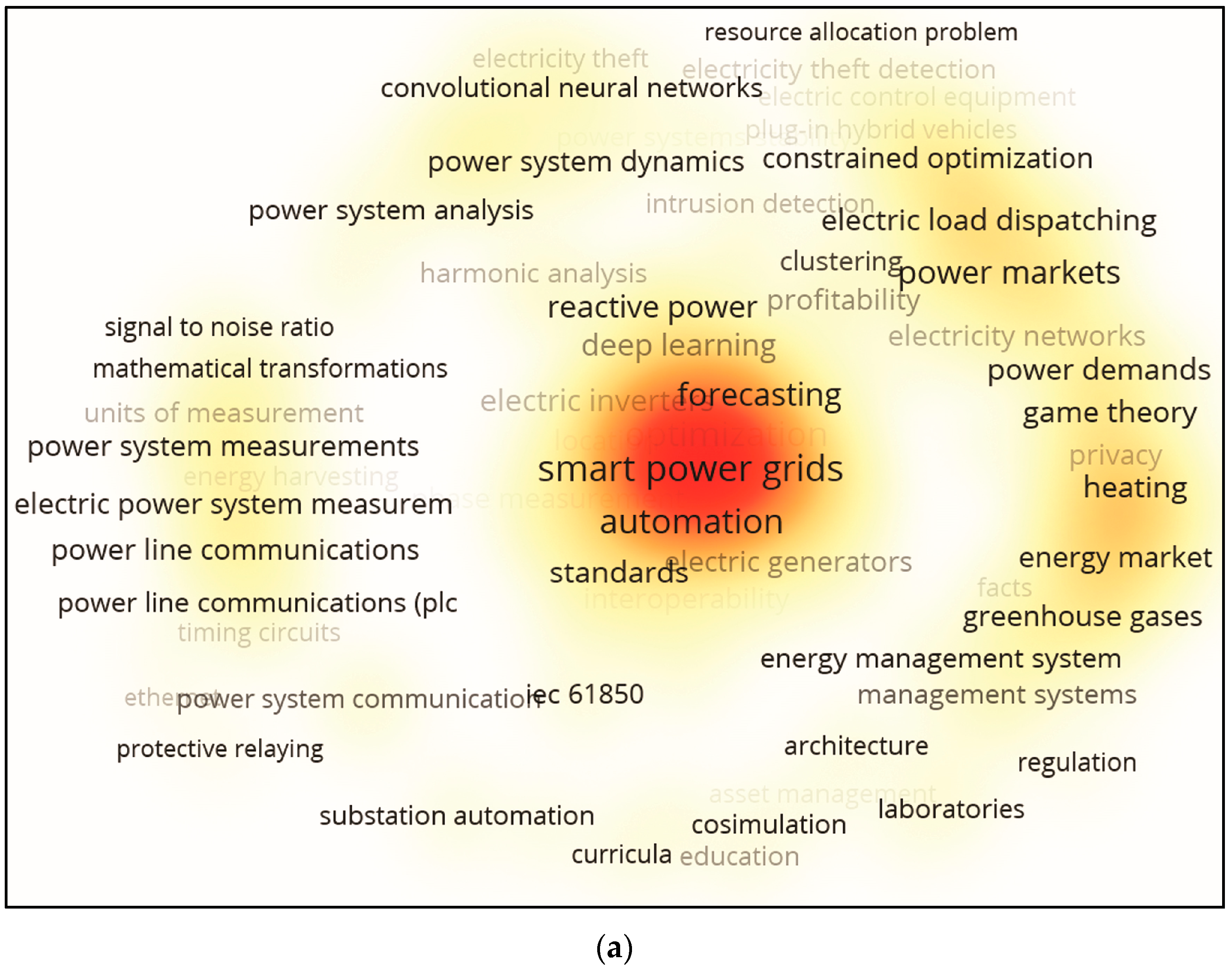
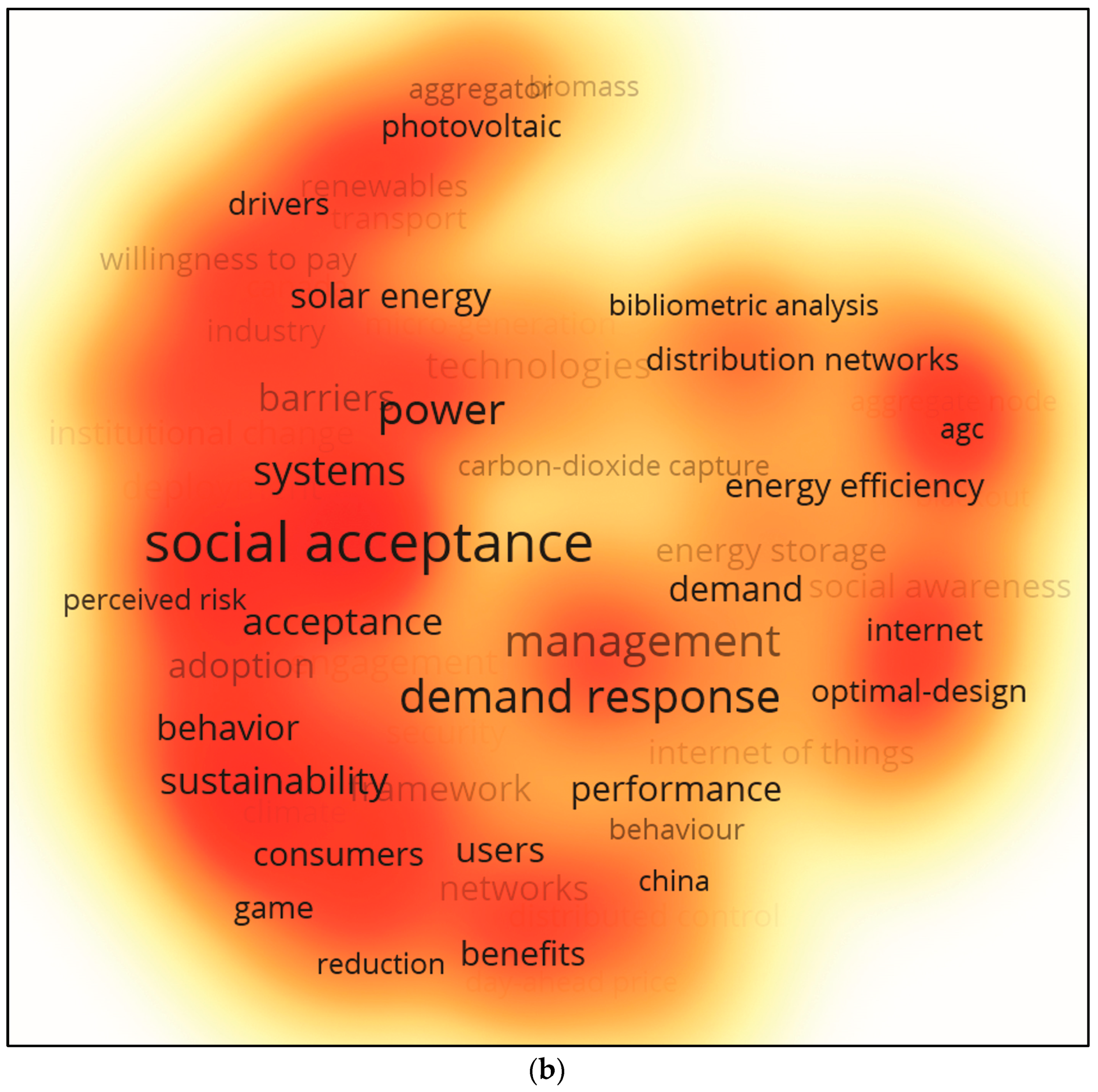
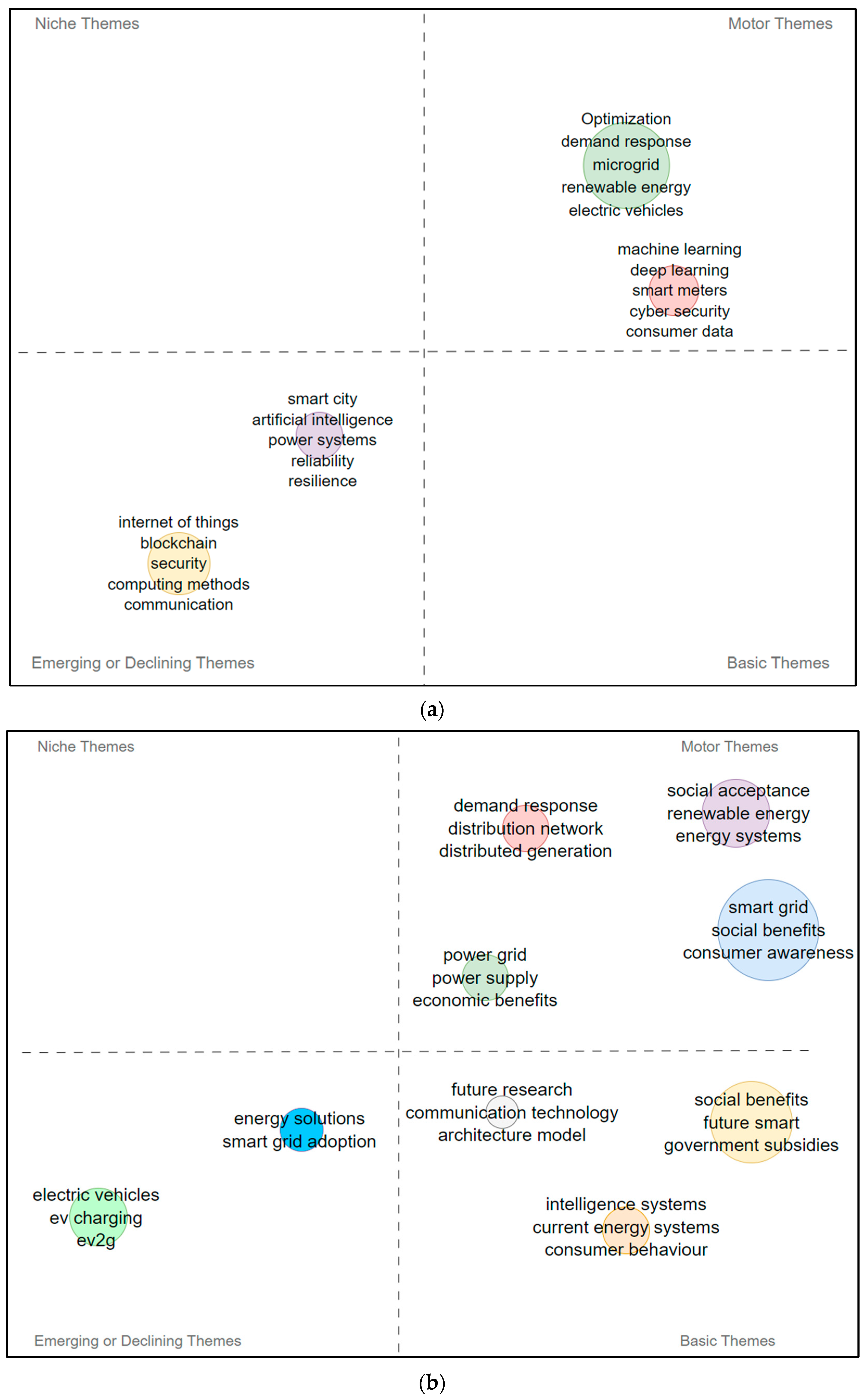
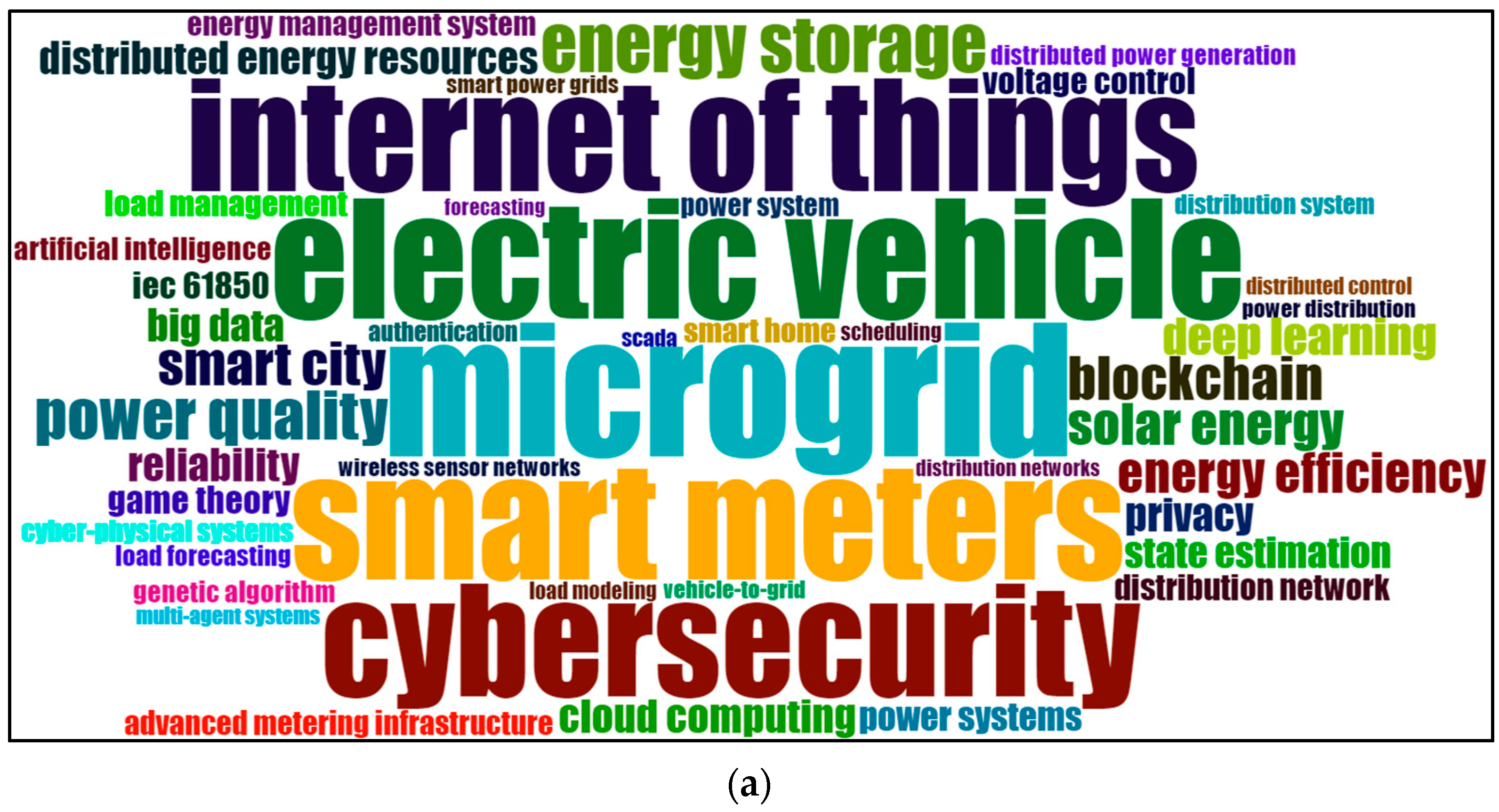
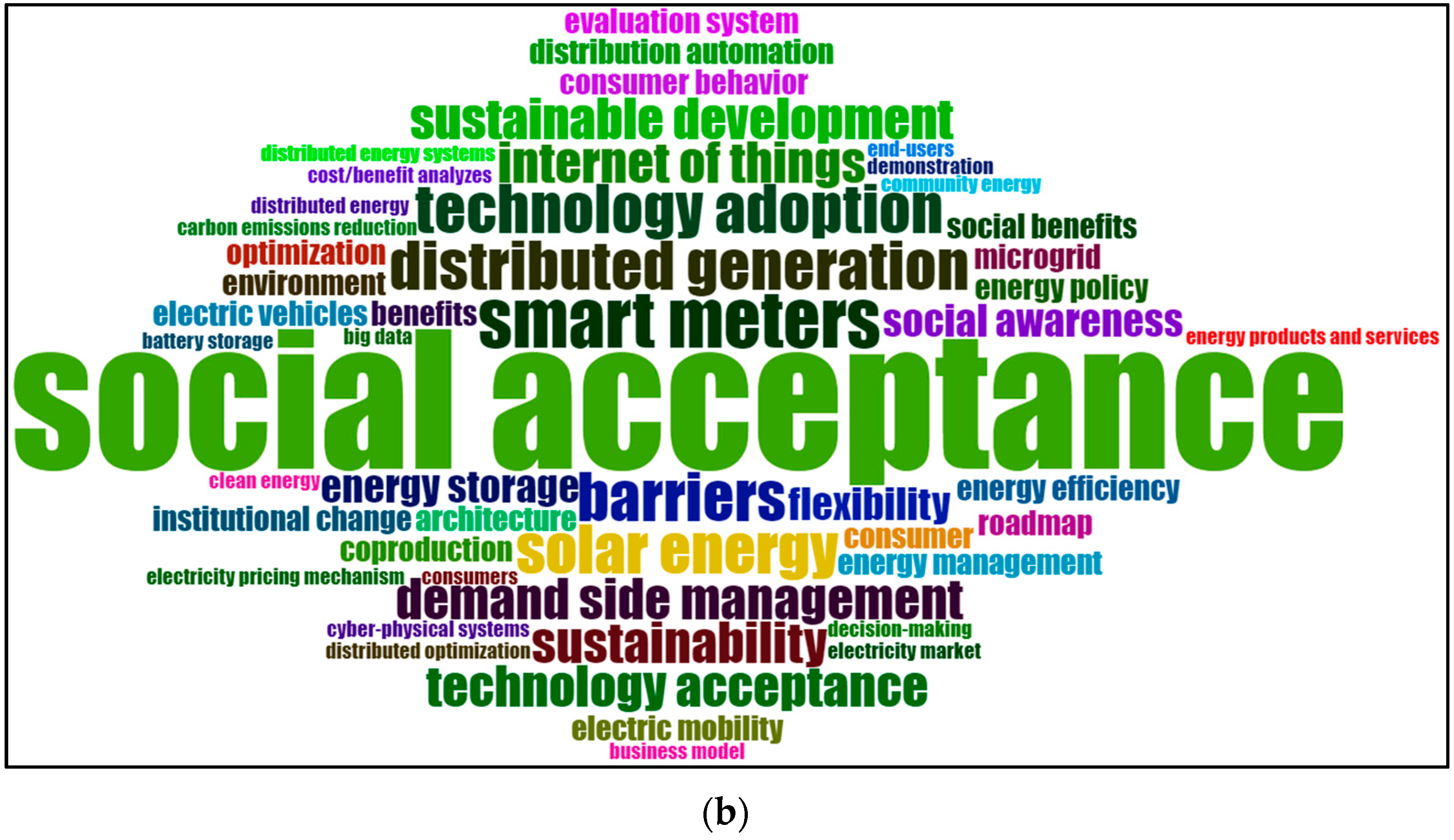
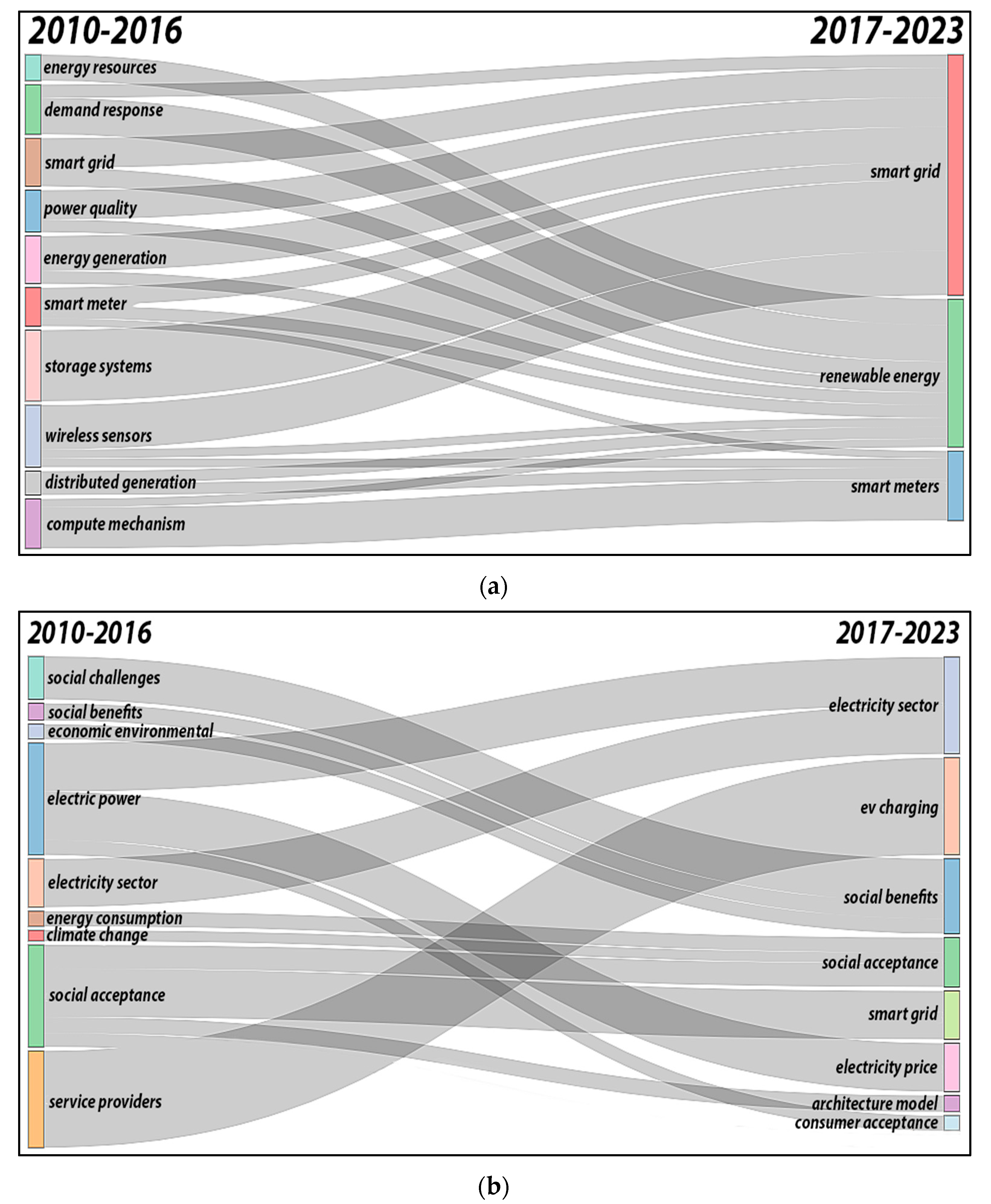
| Main Information | Data 1 (d1) | Data 2 (d2) |
|---|---|---|
| Timespan | 2010:2023 | 2010:2023 |
| Sources (journals, books, etc.) | 8337 | 134 |
| Documents | 41,690 | 181 |
| Annual growth rate % | 2.84 | 0 |
| Document average age | 5.9 | 5.99 |
| Average citations per doc | 16.47 | 21.08 |
| References | 733,818 | 5543 |
| Keywords plus (ID) | 33,610 | 844 |
| Author’s keywords (DE) | 59,551 | 649 |
| Authors | 48,845 | 556 |
| Authors of single-authored docs | 1813 | 17 |
| Single-authored docs | 2544 | 24 |
| Co-authors per doc | 3.79 | 3.61 |
| International co-authorships % | 19.76 | 19.89 |
| Document Types | Data 1 (d1) | Data 2 (d2) |
|---|---|---|
| article | 21,803 | 91 |
| article; book chapter | 448 | 4 |
| article; data paper | 14 | 0 |
| article; early access | 156 | 1 |
| article; proceedings paper | 282 | 2 |
| article; retracted publication | 2 | 0 |
| book | 36 | 2 |
| book review | 7 | 0 |
| correction | 18 | 0 |
| correction; book chapter | 1 | 0 |
| editorial material | 281 | 0 |
| editorial material; book chapter | 61 | 1 |
| editorial material; early access | 2 | 0 |
| letter | 16 | 0 |
| meeting abstract | 6 | 0 |
| news item | 25 | 0 |
| proceedings paper | 17,335 | 38 |
| proceedings paper; retracted publication | 8 | 0 |
| retraction | 2 | 0 |
| review | 1166 | 42 |
| review; book chapter | 6 | 0 |
| review; early access | 14 | 0 |
| review; retracted publication | 1 | 0 |
| Publishers | Data 1 Record Count | Data 2 Record Count |
|---|---|---|
| IEEE | 23,406 | 23 |
| Elsevier | 5966 | 58 |
| MDPI | 2699 | 10 |
| Springer Nature | 2638 | 9 |
| Wiley | 813 | 4 |
| Inst. Engineering Technology-IETT | 468 | 2 |
| Taylor & Francis | 467 | 2 |
| Assoc. Computing Machinery | 434 | 3 |
| Trans Tech Publications Ltd. | 274 | 1 |
| Atlantis Press | 258 | 4 |
| SGs—General | SGs—Social | ||
|---|---|---|---|
| Authors | Record Count | Authors | Record Count |
| Javaid N | 309 | Wolsink M | 4 |
| Zhang Y | 230 | Chalvatzis KJ | 2 |
| Vale Z | 201 | Chawla Y | 2 |
| Wang Y | 183 | Gerards MET | 2 |
| Liu Y | 141 | Hurink JL | 2 |
| Li Y | 140 | Kowalska-Pyzalska A | 2 |
| Catalao JPS | 128 | Li X | 2 |
| Siano P | 117 | Papapostolou C | 2 |
| Liserre M | 114 | Reijnders VMJJ | 2 |
| Li X | 110 | Sovacool BK | 2 |
| Chen Y | 108 | Stephanides P | 2 |
| Li J | 103 | Zafirakis D | 2 |
| Kumar N | 97 | Adil AM | 1 |
| Mouftah HT | 97 | Ahmad A | 1 |
| Zhang J | 94 | Ahmad F | 1 |
Disclaimer/Publisher’s Note: The statements, opinions and data contained in all publications are solely those of the individual author(s) and contributor(s) and not of MDPI and/or the editor(s). MDPI and/or the editor(s) disclaim responsibility for any injury to people or property resulting from any ideas, methods, instructions or products referred to in the content. |
© 2023 by the authors. Licensee MDPI, Basel, Switzerland. This article is an open access article distributed under the terms and conditions of the Creative Commons Attribution (CC BY) license (https://creativecommons.org/licenses/by/4.0/).
Share and Cite
Senyapar, H.N.D.; Bayindir, R. The Research Agenda on Smart Grids: Foresights for Social Acceptance. Energies 2023, 16, 6439. https://doi.org/10.3390/en16186439
Senyapar HND, Bayindir R. The Research Agenda on Smart Grids: Foresights for Social Acceptance. Energies. 2023; 16(18):6439. https://doi.org/10.3390/en16186439
Chicago/Turabian StyleSenyapar, Hafize Nurgul Durmus, and Ramazan Bayindir. 2023. "The Research Agenda on Smart Grids: Foresights for Social Acceptance" Energies 16, no. 18: 6439. https://doi.org/10.3390/en16186439
APA StyleSenyapar, H. N. D., & Bayindir, R. (2023). The Research Agenda on Smart Grids: Foresights for Social Acceptance. Energies, 16(18), 6439. https://doi.org/10.3390/en16186439








